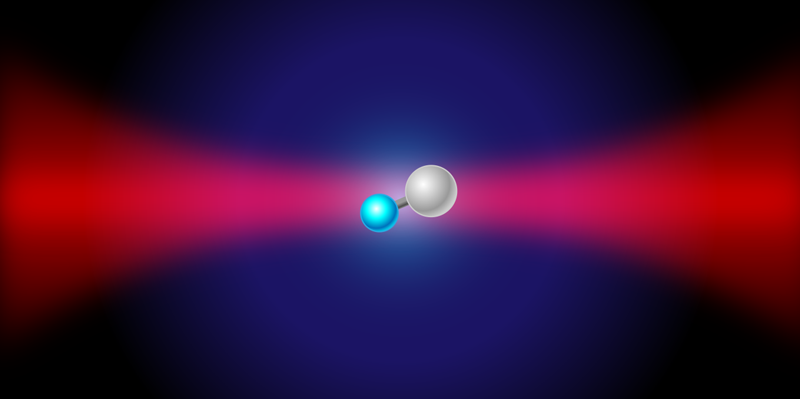A Quantum Molecular Assembler
Researchers have demonstrated a quantum molecular assembler—a device that takes individual atoms as inputs and merges them into a molecule in a desired quantum state. The team used lasers to trap and cool one sodium (Na) atom and one cesium (Cs) atom, bring them together, and merge them into an NaCs molecule in a specific quantum state. Such a quantum-controlled molecule is a promising building block for quantum computers and could help researchers study the quantum details of chemical reactions.
Conventional chemistry experiments involve measurements averaged over billions of molecules, each coming in a mixture of vibrational, rotational, and electronic states. But if you want to learn about quantum effects in chemistry, it would be ideal to use single molecules in precisely defined quantum states. Several research teams, including one led by Kang-Kuen Ni of Harvard University, have recently pursued various strategies for producing such molecules. One possibility is to start with existing molecules and use lasers to cool them (reduce their motion) and to manipulate their quantum states. However, only a handful of molecules are amenable to laser cooling, and the lowest accessible temperatures to date are much higher than those obtained with atoms.
An alternative approach is to assemble single molecules from individual atoms, which could allow a greater degree of control for a larger range of molecules. In 2018, Ni’s team demonstrated an important step in this so-called quantum assembler approach [1]. The researchers took two isolated atoms of different species (sodium and cesium) and combined them into a single NaCs molecule. The scheme, however, could not control the quantum state of the product molecule.
In the new work, the team has refined their technique and demonstrated “quantum control” over the final state. Two important ingredients allowed them to achieve this feat: preparing the initial atoms in pristine quantum states and binding them together through a laser-induced transition that forms a molecule in a selected quantum state.
The researchers started by grabbing the two atoms with separate optical tweezers (laser traps) having different wavelengths. They then used additional beams to cool the atoms to their motional ground states, the states where the atoms move in their traps as slowly as is allowed by quantum mechanics. After crossing the two tweezer beams and turning off the sodium tweezer, both atoms were left at the focus of the cesium tweezer. During this sequence of events, careful control of the laser beams’ intensities and fluctuations ensured that the tweezers didn’t heat up the atoms and kick them out of their ground states. In the final step, two simultaneous laser pulses hit the atoms, causing a transition to a weakly bound molecule in its electronic and rotational ground state and in a vibrational state with 24 quanta of excitation.
Unfortunately, the molecule remained in this quantum state for a very short time, as photons from the lasers caused it to be excited into a range of other states. But some tweaks to the scheme could solve the problem, says Ni. Assuming these tweaks work, a longer-lived molecular state would allow time for additional laser pulses to transfer the molecule from the vibrationally excited state to the ground state. Producing single molecules in such long-lived, pure quantum states is the researchers’ ultimate goal.
Ni is optimistic about applications of this research. “These quantum-controlled molecules would be ideal quantum building blocks for computers and simulators,” she says. The molecules could serve as quantum bits (qubits) that could store information for very long times in their internal hyperfine states, which are insensitive to environmental disturbances. And thanks to the ability of NaCs molecules to interact with each other, each molecular qubit could easily “talk” to other qubits to carry out logical operations.
Kaden Hazzard, who leads a theory group at Rice University in Houston, says that these molecules could transform our understanding of chemistry. “Molecules assembled with the new method could provide an exceptionally clean way of looking at a chemical reaction,” Hazzard says. One could prepare two single molecules in desired quantum states and determine, for instance, how the rate of a chemical reaction between the two molecules depends on these states. Hazzard says that this information could help researchers refine chemical reaction theories that guide the engineering of new drugs.
This research is published in Physical Review X.
–Matteo Rini
Matteo Rini is the Editor of Physics Magazine.
References
- L. R. Liu, J. D. Hood, Y. Yu, J. T. Zhang, N. R. Hutzler, T. Rosenband, and K.-K. Ni, “Building one molecule from a reservoir of two atoms,” Science 360, 900 (2018).





